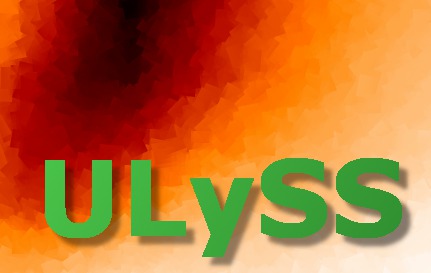
|

|
;+ ; NAME: ULY_SSP_INTERP ; ; PURPOSE: Get interpolated spectrum for logT, Met and [Mg/Fe] ; ; USAGE: model_new = uly_ssp_interp(model_grid, para) ; ; DESCRIPTION: Interpolate spectrum from a grid of models at given ; log(age), [Fe/H] and [Mg/Fe]. Use ULY_2DERIV and ; INTERP_3D. Called, for example, from ULY_SSP_EXTR ; and ULY_FIT_LIN. ; ; ARGUMENTS: ; model_grid: Grid of model (structure) ; [x, y, mgfe]: Log of age (Myr); metallicity (dex); [Mg/Fe] ; ; RETURN: Interpolated spectrum (array) ; ; EXAMPLE: Read a model grid and then extract a spectrum at ; given 10 Gyr and solar metallicity ; model_grid=uly_ssp_read(uly_root+'/models/PHR_Elodie31.fits') ; model = uly_ssp_interp(model_grid, [alog(10000), 0.0]) ; ; AUTHOR: Philippe Prugniel ;- ; CATEGORY: ULY_SSP ;----------------------------------------------------------------------------- function uly_2deriv,x,y ; ; NAME: ULY_2DERIV ; ; PURPOSE: Compute the 2nd derivatives of Y(L,N) at points Xi (i=0,..N) ; ; USAGE: ; y2 = uly_2deriv(x,y) ; DESCRIPTION: ; Given arrays X of length N and Y of size LxN containing a ; tabulated function, i.e. ; Yi = f(Xi), with X1 < X2 < ... < Xn, ; this routine returns and array Y2 of size LxN which contains ; the second derivatives in the second coordinates of the ; interpolating function at the tabulated points Xi. ; ; Used by the functions ULY_SSP_INTERP and DERIVE_3D ; ; ; ARGUMENTS: ; x: independent variable vector ; y: dependent variable vector ; ; RETURN: ; y2: second derivatives at all x, of length n ; the type of y2 is of the highest precision of x and y ; ; HISTORY: ; D. Neill, October, 1991 ; http://www.astro.washington.edu/deutsch-bin/getpro/library43.html?SPLINT ; adapted for ULySS, Mina Koleva & Philippe Prugniel 20070308 ;- ;------------------------------------------------------------------------------ s = size(y) n = s[2] if s[2] ne n_elements(x) then message, 'X and Y should have the same length' type = size(y, /TYPE) > size(x, /TYPE) y2 = make_array(s[1],n, /NOZERO, TYPE=type) u = make_array(s[1],n, /NOZERO, TYPE=type) ; ; The lower boundary condition is set to be "natural" ; y2[*,0] = 0. u[*,0] = 0. ; ; This is the decomposition loop of the tridiagonal algorithm. Y2 and ; U are used for temporary storage of the decomposed factors. ; We make the choice of using loops along the interpolating region ; rather than using TRISOL or SPL_INIT, because this allows to use ; array operations along the other axis. This is the best solution because ; this other axis is in principle much longer (i.e. it is the number ; of wavelength points and is >10 times larger than the length of the ; interpolated axis). ; tsig = double((x - shift(x, -1))) / (shift(x, +1) - shift(x, -1)) status = check_math(MASK=32) ; this function may generate underflows for i=1,n-2 do begin p = tsig[i] * y2[*,i-1] + 2. y2[*,i] = (tsig[i]-1.) / p u[*,i]=( 6. * ((y[*,i+1]-y[*,i]) / (x[i+1]-x[i]) - (y[*,i]-y[*,i-1]) $ / (x[i]-x[i-1])) / (x[i+1]-x[i-1]) - tsig[i]*u[*,i-1]) / p endfor ; The upper boundary condition is set either to be "natural" ; y2[*,n-1] = 0. ; ; This is the backsubstitution loop of the tridiagonal algorithm ; for k=n-2,0,-1 do begin y2[*,k] = y2[*,k] * y2[*,k+1] + u[*,k] endfor if status eq 0 then status = check_math(MASK=32) ; dismiss underflows return, y2 end ;----------------------------------------------------------------------------- function interp_3d, x, y, TMPARR=tmparr, D2X=d2x,$ XGRID=xgrid, YGRID=ygrid compile_opt idl2, hidden ; NAME: INTERP_3D (internal routine) ; ; PURPOSE: Interpolate in a data cube ; ; USAGE: z = interp_3d( x, y, TMPARR=tmparr, D2X=d2x,$ ; XGRID=xgrid, YGRID=ygrid) ; DESCRIPTION: Interpolate in a data cube (tmparr) at (x,y) coordinates ; ; ARGUMENTS: ; x, y: The demanded coordinates at which the cube should be ; intepolated ; ; KEYWORDS: ; TMPARR : model cube ; D2X : array of X 2nd derivatives (input) ; XGRID : array of X for the cube (input) ; YGRID : array of Y for the cube (input) ; ; HISTORY: <unknown> author if not finite(x) then message, 'Input (X) is not finite' s = size(tmparr) if(x gt max(xgrid)) then x = max(xgrid) if(y gt max(ygrid)) then y = max(ygrid) if(x lt min(xgrid)) then x = min(xgrid) if(y lt min(ygrid)) then y = min(ygrid) if(s[0] eq 1) then return, tmparr ; t=systime(1) if((s[0] eq 3) and keyword_set(d2x) and (s[3] ge 4)) then begin ; determine in what region is the point[x,y] xval = interpol(findgen(s[2]), xgrid, x) ; yval = interpol(findgen(s[3]), ygrid, y) xmin = floor(xval) xmax = xmin + 1 if(xmax ge s[2]) then xmax=xmin ymin = floor(yval) ymax = ymin + 1 if(ymax ge s[3]) then ymax=ymin ys1 = ymin - 1 ;limit for the spline if(ys1 lt 0) then ys1 = ys1 + 1 ys2 = ys1 + 3 ;we need 4 points of metallicities to make spline if(ys2 ge s[3]) then begin ys2 = s[3] - 1 ys1 = ys2 - 3 endif intvec = dblarr(s[1], /NOZERO) ;init. interpolated vector ;interpolate along x direction for the 4 y nodes that we need for the ;spline in y h = (xgrid[xmax]-xgrid[xmin]) ax = (h eq 0d) ? 0 : (xgrid[xmax]-x) / h ; ax = (xgrid[xmax]-x) / (xgrid[xmax]-xgrid[xmin]) bx = 1.0d - ax cx = (ax^3-ax) * ((xgrid[xmax]-xgrid[xmin])^2) / 6d dx = (bx^3-bx) * ((xgrid[xmax]-xgrid[xmin])^2) / 6d mm = reform(ax*tmparr[*,xmin,ys1:ys1+3]+bx*tmparr[*,xmax,ys1:ys1+3]+$ cx*d2x[*,xmin,ys1:ys1+3]+dx*d2x[*,xmax,ys1:ys1+3], s[1], 4) d2y = uly_2deriv(ygrid[ys1:ys1+3],mm) h = (ygrid[ymax]-ygrid[ymin]) ay = (h eq 0) ? 0 : (ygrid[ymax]-y)/h ; ay = (ygrid[ymax]-y)/h by = 1.0d - ay cy = ay^3 - ay dy = by^3 - by intvec[*] = ay*mm[*,ymin-ys1]+by*mm[*,ymax-ys1]+$ (cy*d2y[*,ymin-ys1]+dy*d2y[*,ymax-ys1])*(1d/6d)*(h^2) endif else begin if s[0] ne 3 then message, 'The model grid must be 3D' if s[3] le 4 then message, 'The grid must have > 3 points for spline interpolation' endelse ; print, 'TIME INTERP 3D',systime(1)-t return, intvec end ; ---------------------------------------------------------------------------- function uly_ssp_interp, model_grid, para compile_opt idl2, hidden; para[0] : log age ; para[1] : metallicity ; para[2] : Mg/Fe ; Diagnostic required extrapolations m0 = min(*model_grid.o_age, MAX=m1) if para[0] lt m0 or para[0] gt m1 then message, /INFO, 'Requested age is out of range ... extrapolation' m0 = min(*model_grid.o_metal, MAX=m1) if para[1] lt m0 or para[1] gt m1 then message, /INFO, 'Requested [Fe/H]='+$ strtrim(para[1],2)+' is out of the valid range ('+strtrim(m0,2)+$ ','+strtrim(m1,2)+') ... extrapolation' if size(*model_grid.data, /N_DIM) gt 3 then begin ; grid with Mg/Fe resol if size(*model_grid.data, /N_DIM) ne 4 $ or (size(*model_grid.data, /DIM))[3] ne 2 then $ message, 'Support on grid with 2 [Mg/Fe] levels)' inpmgfe = *model_grid.o_mgfe const = (exp(inpmgfe[1])-exp(para[2])) / (exp(inpmgfe[1])-exp(inpmgfe[0])) return, const * $ interp_3d(para[0], para[1], TMPARR=(*model_grid.data)[*,*,*,0], $ D2X=(*model_grid.d2t)[*,*,*,0],$ XGRID=*model_grid.o_age, YGRID=*model_grid.o_metal) + $ (1. - const) * $ interp_3d(para[0], para[1], TMPARR=(*model_grid.data)[*,*,*,1], $ D2X=(*model_grid.d2t)[*,*,*,1],$ XGRID=*model_grid.o_age, YGRID=*model_grid.o_metal) endif else $ return, interp_3d(para[0], para[1], TMPARR=*model_grid.data, $ D2X=*model_grid.d2t,$ XGRID=*model_grid.o_age, YGRID=*model_grid.o_metal) end ; ---- end -------------------------------------------------------------------